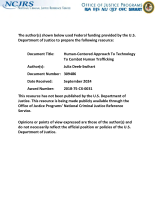Investigations
Expanding the Capabilities of Firearm Investigations: Novel Sampling and Analytical Methods for Gunshot Residue Evidence
Principles of Forensic Audio Analysis
Eyewitness Identification: A Systematic Investigation of Lineup Composition and Fairness
An Investigation of Intrinsic and Extrinsic Factors that Influence Soil Microbial Succession During Human Decomposition
Improving the Investigation of Violent Crime: The Homicide Investigation and Tracking System (HITS)
Exploration of Electromagnetic Fields and System Applications Relating to the Ported Coaxial Cable Sensor (PCCS), Final Report, Volume II: Investigation of the Feasibility of a Long Line Intrusion Sensor System
Investigation of Water Effect on Ignitable Liquid Residue Analysis by Coupling Solid-Phase Microextraction with Direct Analysis in Real Time Mass Spectrometry
Identification and Investigation of the Intrinsic Receptor Activation Potential and Metabolization of the New Oxo-Pyridyl Synthetic Cannabinoid Receptor Agonist CH-FUBBMPDORA
Experimental and Numerical Investigation of Gypsum Calcination under Fire Exposure
Experimental and Numerical Investigation of Gypsum Calcination under Fire Exposure (Thesis)
Further Development of Raman Spectroscopy for Body Fluid Investigation: Forensic Identification, Limit of Detection, and Donor Characterization
Law Enforcement Agency Practices and Policies for the Investigation of Child Sex Trafficking: Are Agencies Using Victim-Centered Approaches?
The Off-season of Dental Cementum Investigations. A Critical Appraisal of Season-of-death Prediction in Medico-legal Investigations
Public Surveillance Cameras and Crime: The Impact of Different Camera Types on Crime and Clearances
Advancing Justice for the Missing and Unidentified Through Research - 2024 NIJ Research Conference
Forensic science research is developing essential knowledge to fill in the holes in death investigations, creating new ways to identify challenging skeletal remains. These methods inform cause of death, time of death, and familial relationships to guide investigations, identify suspects, support prosecutions, and bring justice to families.
See the YouTube Terms of Service and Google Privacy Policy




